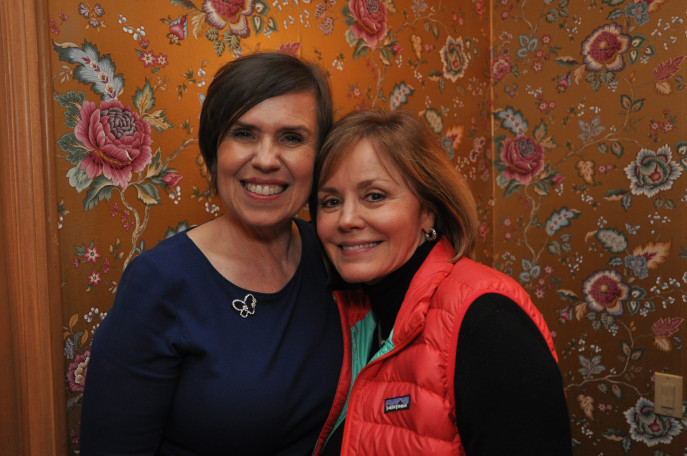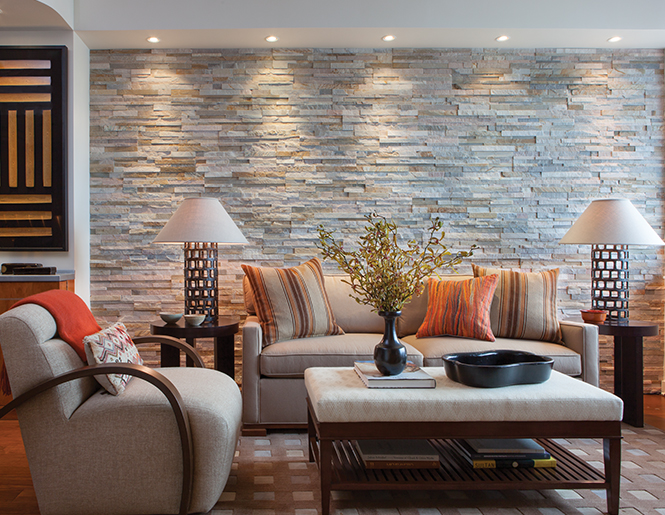
I recently had the honor of being interviewed by my good friend Debbie Phillips for Women on Fire, the group she founded to bring an amazing circle of fabulous women together for inspiration, strategies and support. The following is a transcript of part one of our talk on Your Sacred Space: How to Create an Inspired, Healthy Living Environment.
Debbie: Hello, Woman on Fire! Women on Fire is one of the most dynamic communities of women you will find anywhere. And my guest today highlights the bonanza of talent and expertise we have inside our organization. Today’s interview is part of our series on exploring Your Life. Each month for a year, we are presenting a life topic with strategies on living your best, healthiest and most inspired life. Last month we looked at Your Health and Wellbeing, and today we are discussing Your Sacred Space. Our guest expert, Trudy Dujardin, is a pioneer and a leader in green design and eco-conscious living. She is a nationally recognized interior designer who will share her valuable tips with us today for creating your own healthy, sacred environments. And she will tell us why it’s essential to your good health and your family’s health to live this way.
A little about Trudy before I bring her on: Trudy Dujardin is the president of Dujardin Design Associates based in Westport, Connecticut, and on Nantucket Island in Massachusetts. For more than 25 years, she has designed some of the most elegant homes on Nantucket, in Connecticut, and throughout the country. Her interior design firm is nationally recognized by industry experts, the media nad her clients for her distinctive eco-elegant desings. She is a professional member of the American Society of Interior Designers, and she is a LEED Accredited Professional, recognized for her expertise in sustainable design and construction. Trudy was one of the early pioneers to use non-toxic materials to create interiors rich in beauty and full of health. Her personal journey includes a struggle with multiple chemical sensitivities, yet today she is fully recovered and passionately carries her message that a healthy home is the ultimate luxury to her friends and clients, and the audience of her widely read blog, HolisticHouse.com.
Trudy is someone I know well, and I love and respect her personally and professionally. She has influenced my taste and my style and my thinking for more than a dozen years. Trudy is married to handsome Frank, and they have three amazing Bichon Frises, the cutest little white dogs you’ve ever seen. Plus, I am so proud that Trudy is one of our Women on Fire members. When I want to take a vacation, I go to Trudy’s website and blog; I’m not kidding, her work is so extraordinary that to luxuriate in her website for a while is just like going on vacation. Welcome, Trudy Dujardin!
Trudy: Hello! Thank you so much. I’m thrilled to be here.
Debbie: Aww, I’m happy to share you with Women on Fire. I know a lot of women who have attended tea parties (Women on Fire signature gatherings) know you and you know them. I just want to introduce you to everyone else who hasn’t had that pleasure yet. And our first question always is–and you know this, Trudy, because you get the membership packet–our tradition: What’s your day been like so far?
Trudy: My day was pretty interesting so far. I usually get up sometime between 3:30 and 5:00 every morning because I have, as we talked about, my three Bichons, and they’re the loves of my life. They make me laugh out loud every day. But two of them are almost 11, and they can’t make it through the night. So when I wake up in the middle of the night, I worry about them. I tiptoe downstairs, trying not to wake anybody else up, let them out, bring them in, and give them a little rice cracker. Then I sneak back upstairs to try to catch another 40 winks. If I have a heavy workload, I lie there and think about my day. But I always start my day with prayers. I have two that I say every morning, and it helps me focus on my day. But I have another favorite, Debbie. Do you remember Shakti Gawain?
Debbie: Of course I do.
Trudy: I love her, and I have an old tape of hers. It’s not even a DVD/CD. It’s an old audiotape, and it’s a visualization technique. So I visualized this morning how our interview would go and our wonderful day. Next–I don’t get a lot of points for this because I haven’t been doing this for long–but at 7:30 I got in the car and headed to the gym, where I worked out with a trainer from 8:00 to 9:00. And so that everybody knows, I’m not a saint. I don’t do that all the time. I had fallen off the exercise wagon for a long time because of my business travels, and I decided on the first of the year that I needed to get going again. So last week I began, and I’m thrilled to be back. It just feels good. It sets my day on the right path. And then finally, I came back, ate breakfast, showered, and here I am with you! And I love having you all to myself!
Debbie: Excellent! Well, good for you!
Trudy: Later on, I’ll be working with a new project. Debbie, I’ve been asked to sit on the board of a new organization called Her Haven. It’s the creation of Carey Dougherty (founder and executive director) and she is an amazing woman. I just want to tell you about it, as I’m brand new to it. But what Her Haven does–it’s right up your alley–is to create environments for women in need. They get applications, and it’s kind of like makeovers, but they find out what they woman might need to do. It could be somebody who really wants to be a writer, but she has so many kids and works, and so they create a little haven in her home. And that’s why it’s called Her Haven.
Debbie: I love that.
Trudy: For the project we’re working on now, Carey has been interviewing the PTA at Sand Hook, Connecticut. We all know what’s going on there and what a tragedy it was. But we are trying to see if maybe they need something in the teachers’ lounge that will help comfort the teachers, a respite where they can go. Or if there is a particular person in that town who may need Her Haven. So that’s our mission and that’s to be continued. I’ll fill you in on that more later.
Debbie: Oh, I love it, and you’re such a perfect person to be on that board.
Trudy: I’m bringing in the “green” element.
Debbie: Well, I love it. That’s fantastic. So let’s talk a little bit, Trudy, about how old you were when you first knew you wanted to be a designer.
Trudy: I’m not sure of the exact age, but what my parents told me is that I wasn’t even two and I was already sketching. The interesting thing is I was always sketching rooms, environments. They were almost like stage sets.
Debbie: I just wondered, you said you were two years old and you were sketching? Were you sketching with crayons?
Trudy: Pencils.
Debbie: Pencils. Wow!
Trudy: And then crayons.
Debbie: Do you have any of those sketches? Did your parents save them?
Trudy: Oh, I’m sure there’s a box in the attic somewhere.
Debbie: Well, tell us more about what inspired you to work in the field of design. So you grew up loving to sketch, but then was there anything in particular?
Trudy: My uncle–my father’s brother–was a furniture designer. So, of course, that was a direct lead in. He had gone to the New York School of Interior Design, and back in the 1950s and 60s, when I was a tiny little kid, they used to take me to his studio in Greenwich Village. I was so fascinated by it. I would see these huge, thick slabs of marble and walnut. He had a very elite clientele. he was making racetrack-oval dining tables long before that was the fashion. He was really ahead of his time. We still have some of his furniture now. It’s classic and timeless. it should be in the Museum of Modern Art. Just wonderful. He was the inspiration for the art side of it. My first present from him was his own wooden briefcase full of all his oil paints. I carried that with me every day when I went to graduate school at New York University. Now, for the flip side of the family, we go scientific, medical and then artistic. My father worked for NASA. He was in the space program, and he was a design engineer. He designed thins such as the tile dial, as it was called for the space shuttle. You know how the nose cone is all covered in tile for re-entry?
Debbie: Oh, I’m quite familiar. My brother Scott worked on the space shuttle from its inception to its last day.
Trudy: My father designed the equipment for measuring how each tile should be slightly different. It’s just amazing. He also designed the Polaris Missile way back in the Cuban Missile Crisis.
Debbie: Oh, my goodness.
Trudy: My mother and I never knew what he was working on because he worked in a think tank with no windows. he said if he had his life to do over again, he would get a job where he worked outside.
Debbie: And now he can.
Trudy: And now he can. Right.
Debbie: I know your father is still alive and well.
Trudy: He is still alive and well. He was my exercise buddy last week. I thought, “I need someone to make me accountable.” So, at 89 years old, he was getting up in the morning and going to the gym with me, just to keep me honest.
Debbie: All right, Dad! Well, Trudy, I love your motto: “A healthy home is the ultimate luxury.” Tell us a little more about that. How did you come up with that? What does that mean exactly?
Trudy: As you know, we have a lot of very high-end clients on Nantucket. I was thinking that they have all these beautiful things, but to really make a house pay off and serve them well, it needs to support their health, which means that the indoor air quality has to be just sterling. It has to be perfect for them, and they can afford it. I’ve been at this since 1987. I was very early in on it, and a lot of the builders on Nantucket thought it was a little loopy. They’d ask, “What do you mean the paint is going to hurt you?” It’s hard for people to change. So I had to educate my clients. They would say, “I don’t have allergies, so that’s not important to me.” And I would say that it’s important for your long-term health. Every item on the face of the earth emits vapors of fumes. They’re called VOCs–Volatile Organic Compounds. All of these things chip away at your armor. So even if you are perfectly health, why start chipping away at it? And then we have to think about our children and our pets and the elderly. If we’re going to spend a lot of money, and have this luxurious home, let’s make it healthy too. Why not?
Debbie: Right. And for our women, it doesn’t matter how luxurious it is. We want to talk today about how anybody an make their home healthy. I’d like to go back, Trudy. How did your passion for “green” begin? You were an interior designer, and you came upon these healthier materials and began to use them.
Trudy: It’s complex. Just the other day I listened to your interview with Agapi Stassinopoulos and I was just so inspired by her and her feelings about her mother. It jarred my memory. But I used to think that the origin was that my former husband and I bought this beautiful piece of property on the harbor in Nantucket, and I was so in love with the island that I wanted to do this project right. I thought it was a really healthy island, so let’s not have things silting off of the property and contaminating the water supply, hurting the scallop population I thought that was the origin of my “greenness,” but then listening to Agapi’s wonderful message the other day, I realized that my mother was terminally ill with breast cancer. She lived only to 51. I helped her through those almost four years, and I realized that I just started questioning everything we were doing, having been raised on a farm in South Carolina with all the crop dusting and pesticides and insecticides. i think I told you that I was the first-born, long-awaited grandchild, and they just cherished me. So they would put me in a cot on a sleeping porch along a whole bank of windows to keep me cool at night. It was nothing for it to be 105 degrees in South Carolina. Then they sprayed my cot with DDT to keep the mosquitoes away. That was probably the origin of the liver issues that caused my chemical sensitivity. Am I answering your question?
Debbie: Yes, you are. And I want to just clarify because a lot of Women on Fire do know Agapi Stassinopoulos, and you are referring to the CD with her on it. It’s quite inspiring.
Trudy: But I want to backtrack a little bit. I think “luxury” means when we luxuriate in something. It doesn’t have to be a half-million-dollar home. It doesn’t have to be anything. The luxury of it is that you’re supporting your health. To me, that’s the ultimate luxury. I talk about how, every day, we’re in containers. We get up in the morning, and we’re in our house. We get in our car, and drive to work. Then we’re in an office building. We put the kids on a school bus and they go to a school. We pick the kids up from school in a car and take them to the music teacher’s house or to the doctor’s office. it’s endless. We’re in a phone booth. We’re in an airport. What I’m striving for is indoor air quality–whatever we put in that space. And the only space you can really control is your own environment, your home, so that everything in there supports your health and wellbeing.
To be continued: in our next segment in July, I talk about my struggle with Multiple Chemical Sensitivity and how I recovered, plus tips on how to make your home healthy and holistic!





